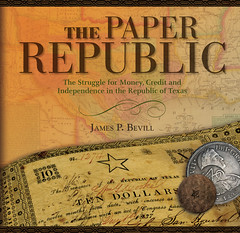
About UsThe Numismatic Bibliomania Society is a non-profit organization promoting numismatic literature. For more information please see our web site at coinbooks.org SubscriptionsThose wishing to become new E-Sylum subscribers (or wishing to Unsubscribe) can go to the following web page link MembershipThere is a membership application available on the web site Membership Application To join, print the application and return it with your check to the address printed on the application. Membership is only $15 to addresses in the U.S., $20 for First Class mail, and $25 elsewhere. For those without web access, write to: David M. Sundman, Secretary/TreasurerNumismatic Bibliomania Society AsylumFor Asylum mailing address changes and other membership questions, contact David at this email address: dsundman@LittletonCoin.com SubmissionsTo submit items for publication in The E-Sylum, just Reply to this message, or write to the Editor at this address: whomren@coinlibrary.com BUY THE BOOK BEFORE THE COINYou won't regret it! |
- WAYNE'S WORDS: THE E-SYLUM JANUARY 10, 2010
- STACK FAMILY NUMISMATIC LIBRARY SALE REPORT
- NEW BOOK: THE PAPER REPUBLIC (OF TEXAS) BY JAMES BEVILL
- NEW BOOK: STANDARD CATALOG OF WORLD GOLD COINS, 1601-PRESENT, 6TH EDITION
- STEPHEN BOBBITT APPOINTED TAMS JOURNAL EDITOR-PUBLISHER
- GEORGE FULD ON CALENDAR MEDALS
- QUIZ ANSWER: THE 1974 ALUMINUM CENT
- VOCABULARY QUERY: A MEDAL WITH PORTRAIT BUT NO NAME
- QUIZ QUIZ: WHAT ARE THESE COINS?
- MICHAEL MAROTTA ON PRINTED NUMISMATIC LITERATURE
- NUMISMATIC VOCABULARY: TRAIL DIES
- CARDBOARD SCRIP NOTES OF LAHAINALUNA SEMINARY, HAWAII
- ALAN WEINBERG ON THE 2010 F.U.N. SHOW
- THE 2003 REUNION OF THE 1913 LIBERTY NICKELS
- 1936 CANADIAN 'DOT CENT' SELLS FOR $402,500
- CENTRAL INTELLIGENCE AGENCY MEDALS
- POUND COINS CONFOUND NORTHERN IRELAND MERCHANTS
- WELCOME TO THE FUTURE
- COIN WORLD SAMPLE ISSUE: VOLUME 1, NUMBER 0
- MORE ON PROCESSING LAS VEGAS CASINO CHIPS
- FEATURED WEB PAGE: MARYLAND COLONIAL CURRENCY 1744-1780
WAYNE'S WORDS: THE E-SYLUM JANUARY 10, 2010

Among our new subscribers this week are Bill Blystone, courtesy of Ed Krivoniak, Ron Ward, John Raymond, Jared Camins, Tim Bishopric, and J. Cuvelier. Welcome aboard! We now have 1,303 subscribers.
John Mutch writes:
Happy New Year - and I am looking forward to another year of E-Sylums - a bright spot in my Sunday evenings!
Thanks - me, too! These issues are always fun to put together despite the work involved. Our subscribers are the best, and I enjoy hearing from all of you. 2009 was a busy year. I did a quick count, and we published about 40 numismatic book reviews and about 60 new numismatic book announcements. It would have been a great year for bibliophiles even without the year's great sales of used and rare numismatic literature.
We have a couple corrections to last week's issue, and as you'll see below one of my gaffes led to a great new article this week. My other mistake was in attributing the item from German magazine "Der Speigel" to reader Werner Talso; actually it was Werner G. Mayer, one of our original members. Sorry!
This week we open with an update on this weekend's Stack Family Library sale, and announcements of two new books. Other topics include trail dies, the new editor of the TAMS Journal, the 1974 aluminum cent, Hawaiian cardboard scrip, the F.U.N. show, the 1913 Liberty Nickels, and more
To learn about jock strap medals and huwasdisguy medals, read on.
Wayne Homren
Numismatic Bibliomania Society
STACK FAMILY NUMISMATIC LIBRARY SALE REPORT
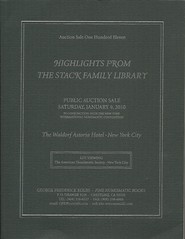 As my E-Sylum publishing deadline approached I
picked up my cell phone and gave Dan Hamelberg a ring. Dan's the President of the Numismatic Bibliomania Society, a completely bonkers numismatic bibliophile, and all-around nice guy. He attended
George Kolbe's sale of the Stack Family Numismatic Library this weekend. George is travelling but I wanted the scoop for my readers.
As my E-Sylum publishing deadline approached I
picked up my cell phone and gave Dan Hamelberg a ring. Dan's the President of the Numismatic Bibliomania Society, a completely bonkers numismatic bibliophile, and all-around nice guy. He attended
George Kolbe's sale of the Stack Family Numismatic Library this weekend. George is travelling but I wanted the scoop for my readers.
In a nutshell, the sale went very well and prices were quite strong. A European buyer was a strong force in the sale. Harvey Stack attended the sale and actually called several of the lots. David Fanning was there manning one of the telephones.
About 70 registered bidders were in the room, along with several on telephones and the Internet. "70" was a magic number - the two highest-grossing lots were the Col. Green papers and photographs, each hammering at $70,000.
Dan bought several lots himself, and I'm sure a number of E-Sylum readers did as well. If you were at the sale, please do write me this week with some of your experiences. I sure wish I could have been there. Meanwhile, I'll await the official post-sale report from George. Congratulations, winning bidders!
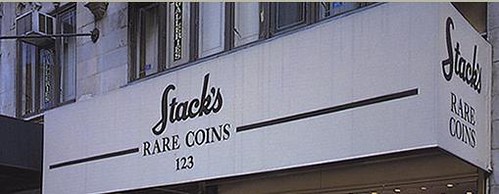
NEW BOOK: THE PAPER REPUBLIC (OF TEXAS) BY JAMES BEVILL
My long awaited tome, The Paper Republic, The Struggle for Money, Credit and Independence in the Republic of Texas was released on Bright Sky Press in Nov 2009. It's available from Amazon. I believe the Amazon reviews by Jim Crisp and David McLemore are the most comprehensive.
When Pasadena native Jim Bevill began writing the book on the early money of Texas four years ago, it began as an outline of the various forms of paper money and the circumstances which led to their issue during the Republic of Texas era (1836-1846).
As he dug deeper into the inner workings of the early Texas Treasury, Bevill unearthed the dramatic economic story of a young government struggling to survive in the throes of a global credit crisis by issuing a plethora of paper obligations in order to survive.
Bevill's book, "The Paper Republic: The Struggle for Money, Credit and Independence in the Republic of Texas," was featured at the 2009 Texas Book Festival in Austin, where it met with rave reviews. According to Dr. Bruce Winders, Curator and Historian at the Alamo , "`The Paper Republic'is history on both the grand and small scale. Moreover, it presents readers with valuable insight into the Republic of Texas that will forever change their view of the revolution and its aftermath."
The book evolved into a powerful financial story on the economic roots of Texas, ranging from the earliest days of Spanish colonization, through the war for independence and the massive buildup of debt through the paper money system under Presidents Burnet, Houston, Lamar and Jones - creating a financial house of cards which eventually led to the annexation of Texas by the U.S. in 1845. This fully illustrated tome enhances the reader's experience by literally following the money through the Republic era to the climactic and shocking chain of events which occurred following Texas' admission as one of the United States.
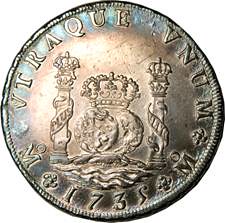
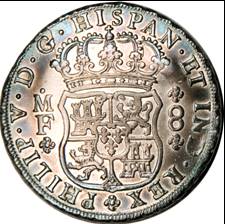
A review by Dr. James E. Crisp, Department of History, North Carolina State University:
"THE PAPER REPUBLIC is first and foremost a visual feast. Jim Bevill has brought together countless high-quality images of original documents from private collections as well as government and university archives -- many of them never seen before by the public. Moreover, he has richly illustrated his fascinating story of the economic struggle in the Texas Republic with hundreds of photographs and engravings rarely seen today. These provide the historical backdrop to the incredibly complex financial history of a genuinely fragile republic that floated paper obligations for a decade on little more than faith, credit, and the heroic exertions of its officers and people."
"Everyone who reads this book will learn much from it, whether they be seasoned collectors, historical scholars, or fascinated readers from the general public. One of the book's most interesting and hitherto least-appreciated revelations is that of the intertwined monetary histories of Hispanic and Anglo America, manifested in coins and currency by such familiar icons as the dollar sign and the lone star emblem of Texas. There are surprises on almost every page -- from gleaming images of the recently unearthed Mexican silver stash dropped by Santa Anna's soldiers at San Jacinto, to the amazing fact that the debts of the Texas Republic were not settled until the presidency of Theodore Roosevelt. This is a book to savor. It will be a valuable resource for generations to come."
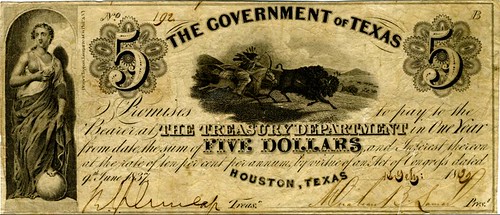
For more information (or to order the book) from Amazon.com, see: The Paper
Republic: The Struggle for Money, Credit and Independence in the Republic of Texas (Hardcover) (www.amazon.com/Paper-Republic-Struggle-Credit-
Independence/dp/1933979259/ref=cm_cr_pr_product_top)
NEW BOOK: STANDARD CATALOG OF WORLD GOLD COINS, 1601-PRESENT, 6TH EDITION
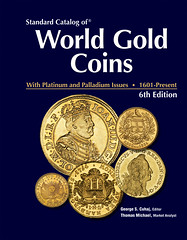 Krause Publications has released the sixth edition of the
Standard Catalog of World Gold Coins, 1601-present, including platinum and palladium issues.
Krause Publications has released the sixth edition of the
Standard Catalog of World Gold Coins, 1601-present, including platinum and palladium issues.
"Gold coins have been the standard store of wealth for mankind for centuries," said market analyst Tom Michael. "Public interest in gold is always simmering below the surface of society and spikes through at various junctures. Gold rushes, gold backing of currencies and of course times of economic downturns such as we are now experiencing worldwide, bring gold into our everyday thoughts, hopes, dreams and investment strategies. Over four centuries of world gold coin production are chronicled in this catalog, with market values reflecting the record highs in today's skyrocketing precious metals market."
The new edition of this book features:
- More than 35,000 photos of coins in their actual size
- Up-to-date market values in up to five condition grades
- Denomination index, bullion value chart, foreign exchange table
- Descriptions with detailed weight and measurement data, a key to detecting counterfeits
- Listings organized alphabetically by country
This 1,440-page book is available at www.shopnumismaster.com/product/std-cat-world-gold-coins/world-coins
STEPHEN BOBBITT APPOINTED TAMS JOURNAL EDITOR-PUBLISHER
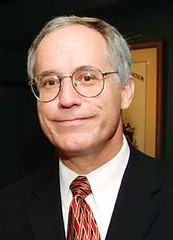 The first issue in the new year of the Token and Medal
Society's bimonthly publication, "TAMS Journal" will be edited by Stephen L. Bobbitt of Colorado Springs. He will hold both positions of editor and publisher formerly held by
Dave Schenkman, editor, and Paul Cunningham, publisher.
The first issue in the new year of the Token and Medal
Society's bimonthly publication, "TAMS Journal" will be edited by Stephen L. Bobbitt of Colorado Springs. He will hold both positions of editor and publisher formerly held by
Dave Schenkman, editor, and Paul Cunningham, publisher.
In an interview this week Stephen states final details are not yet firm, but he expects the Journal will be printed in Colorado Springs. So TAMS members may expect somewhat of a different look to the publication. Further, he stated, it will take a "couple issues under my belt" before his editorial style may be evident to readers. He did receive some articles from former editor Schenkman, but like every editor laments, "there are never enough articles on hand." But, he said, "I will pick up and move forward."
The December 2009 issue of the TAMS Journal, the last to be issued under the dual leadership of Schenkman-Cunningham, carried the article "A Long 'Temporary Assignment' Comes to an End" by David Schenkman. He pointed out that in 1982 he and Paul were asked to take the responsibility of editing and published the topical numismatic publication on a temporary basis.
President at the time, Hal Dunn, had asked the pair to get the publication back on a regular issue basis since it had lapsed to a four-month delay, "until he could find a permanent replacement!" Not only did they overcome the hiatus they accomplish regular publication before long, but thereafter remained in position for 27 years! Hal had found the ideal pair to get the job done even if he had touted it as a "temporary assignment."
In addition under the Schenkman-Cunningham management the pair has issued special issues on token topics within the regular issues and published half a dozen books on specialized topics in the field. Both men can feel proud of their long-term accomplishments. They deserve every accolade TAMS officers and members may offer their way.
Stephen L. Bobbitt, 60, comes to the new assignment with impressive credentials. He has been associated with the American Numismatic Association since 1988, first as public relations director, and later as communications consultant. A long-time journalist he has held positions in the publication field as Southern Colorado correspondent for the Colorado Business Magazine, reporter for the Rocky Mountain News, city editor of the Colorado Springs Sun and reporter for the Colorado Springs Gazette.
He holds a Bachelor of Arts in English from Western State College of Colorado at Gunnison, Colorado. He received the ANA Presidential Award in 1995 and 1999, among numerous journalism awards.
He also will not have far to look for any needed editorial assistance. He is married to Barbara J. Gregory (Bobbitt), editor of The Numismatist. They have been married for seven and a half years.
We are expecting great accomplishments from the high-energy, seasoned journalist in his new editorial position. Congratulations Steve!
THE BOOK BAZARRE
GEORGE FULD ON CALENDAR MEDALS
George Fuld writes:
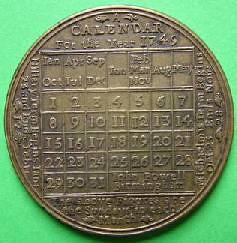 I just brought up the article (circa 2007) mentioned in The
E-Sylum for December 27th. It is interesting but doesn't really get to the point regarding calendars. My father and I wrote up calendar medals and store cards from in The Numismatist
from 1956-59 and 1971-74, listing over 300 different calendars. Serially printed, the listing runs well over 125 pages. I am hoping to reprint these listings but am waiting to get a good OCR program
to scan pages.
I just brought up the article (circa 2007) mentioned in The
E-Sylum for December 27th. It is interesting but doesn't really get to the point regarding calendars. My father and I wrote up calendar medals and store cards from in The Numismatist
from 1956-59 and 1971-74, listing over 300 different calendars. Serially printed, the listing runs well over 125 pages. I am hoping to reprint these listings but am waiting to get a good OCR program
to scan pages.
An article by A. J. Turner in the American Journal of Numismatics volume 5-6 (1993-94) discusses calendars but had no idea about the extensive listings in The Numismatist. A private publication by James O. Sweeny in 2003 is a wonderful listing of British calendars starting with the British Museum copy of Samuel Morlandl of 1650. Recently Bob Levinson of Los Angeles acquired the earliest calendar medal that I know of, dated 1582, listed in the famous Van Loon catalogs from the 1700's.
I am in the process of updating the calendars, especially starting with the 3 inch (76mm) first from the French Mint in 1964 which started series by MACO, Franklin Mint, Hoffman Mint and Metalcraft. Other three-inch medal series are from Korea, Poland and Portugal.
I am preparing a short article for the MCA Advisory on the subject of three-inch medals, (As the token Corresponding Society notes, most medals range from 37-44mm. The 76 size is a new development.
To read the earlier E-Sylum article, see: FEATURED WEB PAGE: CALENDAR MEDALS (www.coinbooks.org/esylum_v12n52a21.html)
QUIZ ANSWER: THE 1974 ALUMINUM CENT
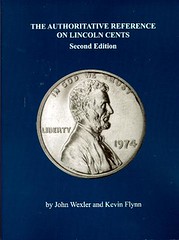 Regarding the cover of
The Authoritative Reference on Lincoln Cents by John Wexler and Kevin Flynn, last week I asked:
Regarding the cover of
The Authoritative Reference on Lincoln Cents by John Wexler and Kevin Flynn, last week I asked:
Why does a 1974 cent rate the cover photo? What's so special about it?
This was an easy one, at least for those of us over a certain age. Paul Horner was the first to write that it's made of aluminum, and John Burns and Fred Reed were close runners-up. David L. Ganz writes:
I never did have the cent but the blank I did retain and it is presently found in the Smithsonian collection.
In March, 1974, I had just left Iola and had started law school. Hearings on the Aluminum cent were announced for March 27. Chuck Holstein, the staff member of the Consumer Affairs subcommittee (chaired by Leonor K Sullivan, D-MO) asked if I wanted to testify, since I was very opinionated that aluminum was a bad choice.
I put in testimony that took a very negative position on how the Mint came about recommending aluminum (it was clear they started with their conclusion and then worked backwards). At the hearing itself, Richard Schreiber of NAMA (merchandising association) brought rejector mechanisms to show how they worked and brought slugs that were real to demonstrate it.
They were passed around for all to see, as were some of the 1974 cents (struck in 1973) that the Mint produced. Those were mostly collected (Holstein kept his in his wallet as did GOP staffer Orman Fink). I asked Schreiber if I could have some of the blanks for my own use. I later donated one of them to the Smithsonian (I saw it when as a member of the Citizens Advisory Committee we took a tour and I asked to see the box it was in. [wow what a sight!]).
Sometime later, Jack Anderson (then Drew Pearson's associate) wrote about the scandal involving 1974 aluminum cents. Chuck sent his to the Smithsonian as a gift to protect it and by that time my planchet was already there,
I missed a day of law school for that, but what a thrill! Just a month before, I had served on the Assay Commission.
VOCABULARY QUERY: A MEDAL WITH PORTRAIT BUT NO NAME
David Gracey writes:
What do you call a medal that features a portrait but does not include the name of the person portrayed? It could be "anonymous" but there is another term... I'm sure one or more readers of The E-Sylum will know.
QUIZ QUIZ: WHAT ARE THESE COINS?
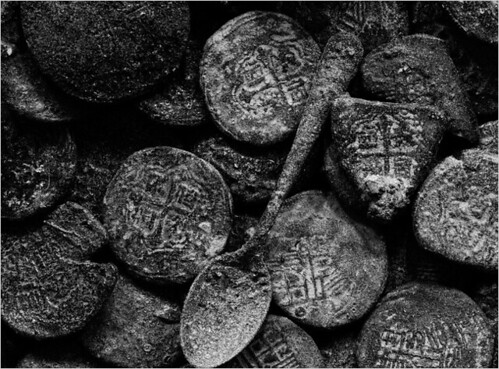
THE BOOK BAZARRE
MICHAEL MAROTTA ON PRINTED NUMISMATIC LITERATURE
I renewed my membership in the ANA, beginning my 16th year in the hobby. I was disappointed by two omissions in the survey. Asking about our interests, there was no check box for Literature. So, I added one and checked it. Also, in the query about which member services we use, the Library was omitted. I fixed that, too.
I chose to receive a printed magazine, which now costs $46 versus $28 for the online version. To me, numismatics is a tactile experience. My preference for print is not despite my being the "Internet Connections" columnist for The Numismatist, but because of it. Computerized media are convenient for lexical searches. The high-resolution graphics blow print away. Nonetheless, the presentation of The Numismatist online is clumsy and inconvenient.
I read so much on the computer that I look forward to relaxing with paper. Moreover, if I want ten copies of an article I wrote, my neighborhood printer offers self-serve black and white or color, one-sided or two, collated and stapled, for a fraction of what I pay to run my own laserjet or inkjet, and with much less hassle.
Of course, numismatics is a hobby of specialties and not all can be listed. Any taxonomy is fated to displease some members of every group, by inclusion, exclusion or marginalization. By definition, no aspect can be central. Every facet of our hobby is truly a window to the core of numismatics. But if not for literature, the artifacts are reduced to mere curios, machine-made peacock feathers: pretty, but not human history.
NUMISMATIC VOCABULARY: TRAIL DIES
Eric von Klinger writes:
I haven't seen the revised edition of the Wexler-Flynn "Authoritative Reference" on Lincoln cents, but your reviewer has B.J. Neff contributing a section on "trial dies." B.J.'s pioneering studies have been on "trail" dies, a different animal altogether. The "trails" are raised marks resembling streaks typically emanating from peripheral lettering.
To read the earlier E-Sylum article, see: BOOK REVIEW: THE AUTHORITATIVE REFERENCE ON LINCOLN CENTS, SECOND EDITION (www.coinbooks.org/esylum_v13n01a04.html)
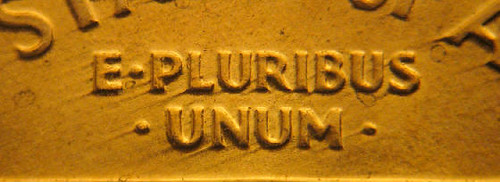
In last week's E-Sylum I wrote a review on The Authoritative Reference on Lincoln Cents Second Edition by John Wexler and Kevin Flynn. In the review there was an error in the spelling of a new variety of Lincoln cent, which was discussed in relation to an article on "Trail Dies" by B.J.Neff. This article is meant to clear up that minor detail, but more importantly to discuss Trail and Wavy Step die varieties.
The history surrounding this relatively new variety has in its roots a Lincoln cent submitted for examination by G. J. Lawson to John Wexler in 1994. Upon examination of the coin Mr. Wexler was convinced that the coin in question was a doubled die. In that belief he listed the coin as 1994 1c WDDR-004. But how can this be, you might ask yourself? The United States Mint had just recently changed the production process in order to eliminate doubled dies by converting to the single squeeze hubbing process.
In order for us to understand the single squeeze hubbing process it might be relevant to also understand how the system worked in prior years. In that past, United States Mint technicians used the following process. The approved engraving which is on an epoxy plastic cast is placed on a transfer engraving machine called a Janvier Transfer Engraving machine or pantograph. The pantograph engraves the image on to the Master hub. The Master hub is a tool made in hardened steel that contains an image of the coin. The Master hub is used to impress a coin's image onto a Master Die that is then used to create the Working Hub.
This working hub will be a positive and will have all of the design elements needed to create the dies that will be used in the presses. These dies are called the working dies. The working hub is used many times to create multiple working dies. This process is where most of the design errors occur. The working hub must be inserted into the hubbing press up to four times (up to nine images are known for Morgan dollars, and seven have been known for a foreign coin) in order to create a good transfer to the working die. If during one (or more) of those impressions the working hub or the working die is not seated just so then any number of issues might arise. The most of famous of these is the doubled die.
The "single squeeze" restrained hubbing process was supposed to eliminate this anomaly for the one and five cent coins in the middle part of the 1990's, and for the balance of United States coinage in the years following. The Mint had begun to experiment and to produce coins with the single squeeze method in Fiscal Year (FY) 1986. However as with most things created by man one issue resolved creates another unforeseen. In the year 2000 Kenneth Edgar submitted a coin to Ken Potter (coauthor with Brian Allen) of Strike it Rich with Pocket Change) and the proprietor of Variety Vault on the web. Potter recognized the coin as the 1994 WDDR-004 (Lawson example) attributed it as such, and assigned the numbers 1994 1c VCR#2/DDR#2 to the coin. Ken was also the first person to call the anomaly "Trails" when they occurred on characters or designs outside of the steps.
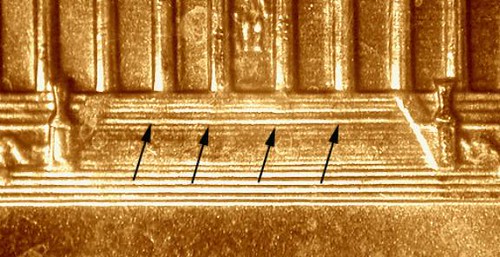
In 2003 Harold Kuykendall wrote to Ken Potter and enclosed a 2003 Lincoln cent for analysis and attribution. Mr. Kuykendall wrote in the letter with his submission that the specimen had what appeared to be "Wavy Steps." These wavy steps are located on the reverse of the coin at the base of the Lincoln Memorial below the columns. The Kuykendall coin not only had the trails and the wavy steps; it was also a Doubled Die. This was simply not supposed to happen with the single squeeze method! Potter was astounded by the find and announced this to the world in article written in several publications.
Shortly thereafter Billy Crawford, another well known numismatist, and variety attributor, discovered a similar 2003 Lincoln cent with the same varietal markings as the Kuykendall specimen. It is at this point in the movie where it was said, "If there is more than one coin Watson, with the exact same markings, you may deduce that you have a die variety," "Quite so Holmes, quite so."
A third variety was found soon after by B.J. Neff, a 1999 Lincoln cent which exhibited the "wavy steps." Since the time of Lawson's discovery over seven hundred different types of the trail and wavy step die variety have been identified. The trail and wavy step variety is not a doubled die and since has been identified as a design extension or a continuation of the design.
I should think it might want to be called a design type variety or just plain design variety. This type of variety and other doubled die coins are the result of die/hub slippage during the hubbing process the result of which are design varieties which are created around the center of the die. This has resulted in hundreds of new types of doubled dies and other design varieties. According to Mr. Neff these varieties are available because they are newly discovered, and there are potentially, many more of these yet to be found in rolls and bags of United States, and other country's coins.
The United States Mint is aware of the issue and acknowledges its existence but to this writer s knowledge has no plans to address it. These coins do command an extra premium, although at this time the market forces seem to be unaware of their existence. There is a website devoted to the subject and which is kept up to date by noted numismatists B.J. Neff and Bob Piazza and it is located at http://traildies.com/, the subject is covered in The Authoritative Reference on Lincoln Cents Second Edition by John Wexler and Kevin Flynn, and it is also covered by Brian Allen and Ken Potter in Strike it Rich with Pocket Change.
The Trail and Wavy Step variety web site is a wonderful place to point your browsers in order to find an encyclopedias worth of information and also the Lincoln Cent Resource on the web at www.lincolncentresource.com/TrailsandWavySteps.html .
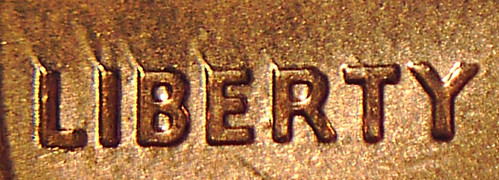
I am not an expert at the inner workings of the United States Mint and have only just read their processes, procedures, and reports. The creation of the master hub, working hubs, and the working dies used to create United States coins and medals is best taught when accompanied by photographs and diagrams. It is a complicated process. If you wish to create a better awareness of the process suggested reading includes The Error Coin Encyclopedia by Arnold Margolis, the publications previously mentioned in this article, and of course you may visit one of the many sites on the web that details the process.
CARDBOARD SCRIP NOTES OF LAHAINALUNA SEMINARY, HAWAII
From the lot description:
Lahainaluna Seminary, Hawaii. Denomination Set of Six Cardboard Scrip Notes. No Date [ca.1843-1844]. Average Choice Extremely Fine.
A superb and extremely rare set of local scrip avidly collected in the Hawaiian series for generations. They were produced locally and for local use. All are uniface on thick card-like stock. They range in size from 30x20mm to 80x45mm. Denominations include Hapumi, 3 Keneta, Hapawalu (1/8 Dollar), Hapaha (1/4 Dollar), Hapalua (1/2 Dollar), and Hookahi Dala (Dollar). A well designed and printed set of "notes" from copper plates.
Listed in Medcalf & Russell as PE-10 to PE-15. The folk-art style is quite exceptional. Supposedly, only 228 sheets of notes were printed on the thin paper and affixed to card stock to circulate as "tokens." There were actually two issues of these. Notes from the first are not known in issued form (only a complete, un-mounted sheet survives) and these notes represent examples from the second issue with differing "secret" marks from the first plate.

To view the complete lot description, see: Lahainaluna Seminary, Hawaii. Denomination Set of Six Cardboard Scrip Notes (http://www.stacks.com/lotdetail.aspx?lsid=AN00000754&lotno=2023)
ALAN WEINBERG ON THE 2010 F.U.N. SHOW
The January Florida United Numismatists (FUN) show , as it has been for decades now, in my opinion continues to be the most entertaining, educational , vibrant and rewarding coin show of every year. Those people in orange jackets really know how to put on an event.
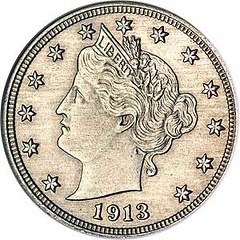 I had doubts the 1913 Liberty nickel
would sell due to the economy. It is true that dealers on the bourse floor were not very aggressive about buying and verbally preferred to accumulate money rather than add to stock. And the buying
public often kept their hands in their pockets out of an abundance of economic caution and unemployment. But Heritage did indeed sell three coins each over a million dollars at auction, proving that
true rarity and numismatic appeal still reigns.
I had doubts the 1913 Liberty nickel
would sell due to the economy. It is true that dealers on the bourse floor were not very aggressive about buying and verbally preferred to accumulate money rather than add to stock. And the buying
public often kept their hands in their pockets out of an abundance of economic caution and unemployment. But Heritage did indeed sell three coins each over a million dollars at auction, proving that
true rarity and numismatic appeal still reigns.
The 1913 nickel opened at $2.75 million dollars. Don Kagin bid $2.8 and the Heritage podium bid $2.9. Heritage's Greg Rohan exercised a client's bid at $3.0 million and Heritage's Todd Imhoff exercised a $3.25 hammer phone bid , amounting to a total of $3,737, 500 with buyer's fee. The 1927 D double eagle sold for a total of $1,495.000 to the Internet - very often a serious dealer/agent or collector preferring anonymity bidding from a hotel room or perhaps even on the auction floor on a laptop computer, just not wanting anyone to see his/her hand raised. And the ultra rare and very "sexy" 1874 Bickford pattern $10 gold proof sold on the floor for $1,265,000 total.
Almost all of Florida was unusually cold, even bitter cold and Orlando was no exception with temps down into the mid 20's. I have little doubt this benefited attendance at the FUN show. It was a good crowd, considering the times.
Next January 2011 it'll be located in Tampa for one year due to the unavailability of Orlando's Orange County Convention Center. I'm told by some Tampa residents at the show that the demographics of downtown Tampa has changed and that's where the Tampa convention center is located. Hopefully FUN will be just as good.
THE 2003 REUNION OF THE 1913 LIBERTY NICKELS
Don Coley writes:
Seeing the news on the Olsen 1913 Nickel takes me back to the Smithsonian as a youngster, 1976 when the Eliasberg Collection was on display. (I still have a photo that I bought from the gift shop, of the Norweb specimen). And to the Baltimore Convention in July 2003 when the Walton specimen was authenticated. That was an amazing course of events. Dwight Manley sells Eliasberg specimen to Ed Lee the night before the authentication. It was really interesting to be at that show!

The Ninety Years of Liberty Gala: A Night in Pictures (scoop.diamondgalleries.com/public/default.asp
?t=1&m=1&c=34&s=265&ai=43900&arch=y&ssd=8/9/2003%2012:01:00%20PM)
Below is some text from the post-sale press release. -Editor
The "Olsen" 1913 liberty nickel sold for $3.7 million "in spirited bidding" to a private East Coast coin collector in Orlando late on Thursday.
Recently dubbed "The Mona Lisa of Rare Coins," The "Olsen" specimen is the second finest of just five known examples and is currently graded PR64 NGC. It was the first 1913 Liberty Head nickel offered for sale in a public auction, and the only specimen that professional numismatist B. Max Mehl ever handled, despite his extensive advertising campaign that promoted the famously rare coin. It also holds the record as the first coin to break the $100,000 price barrier in 1972, while another 1913 nickel, the Eliasberg specimen, became the first coin to break the $1,000,000 price barrier some 24 years later. It is certainly possible that a 1913 Liberty nickel, perhaps the Olsen specimen, will someday become the first coin to break the $10,000,000 price barrier.
1936 CANADIAN 'DOT CENT' SELLS FOR $402,500
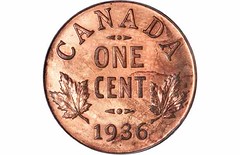 A rare Canadian coin brought in a pretty penny on
Sunday, selling for $402,500 US during a New York auction.
A rare Canadian coin brought in a pretty penny on
Sunday, selling for $402,500 US during a New York auction.
A 1936 Canadian "dot cent" had garnered considerable online traffic after bidding began earlier this week on the Dallas-based Heritage Auctions website.
Only three of such pennies are known to exist; the makeshift coin was struck — but never circulated — after the death of King George V.
Canadian authorities had prepared to produce coins with the effigy of King Edward VIII, who succeeded George V, but Edward VIII then stepped down from the throne to marry an American divorcee and the dies for the coins carrying Edward's image could not be used.
In response, the 1936 coin was put back into production with only a tiny dot below the date to differentiate it.
To read the complete article, see: Canadian 'dot cent' fetches princely sum during
U.S. auction (www.theprovince.com/news/Canadian+cent+fetches+princely
+during+auction/2402294/story.html)
CENTRAL INTELLIGENCE AGENCY MEDALS
I happened to hear part of a National Public Radio story this week about the Central Intelligence Agency. Because of the recent bombing of a CIA station, they were discussing the secrecy surrounding the death of an agent. When an operative is killed, the director of the agency signs a letter of condolence to the person's family. They are handed the letter to read, but then they have to give it back and it's placed in the employee's file at headquarters. The agency also gives medals, and if I heard the story right, those get the same treatment: "Here's your medal. Now give it back."
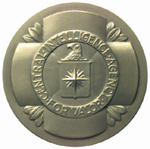
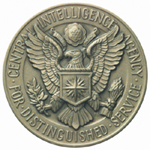
In Wikipedia someone wrote that "CIA medals are often referred to as "jock strap medals" since they are often awarded secretly (due to the classification level of the respective operation) and cannot be displayed, or on occasion, acknowledged publicly."
Curious, I checked the web for information on CIA medals, and found quite a number of different types. There's the Distinguished Intelligence Cross, Distinguished Intelligence Medal, Intelligence Medal of Merit, Career Intelligence Medal and other, in addition to gold, silver and bronze Retirement Medallions. They're not all so super secret. Have these ever been catalogued? Do they pop up on eBay?
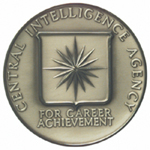
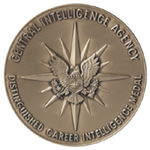
For more information, see: CIA Medals (fas.org/irp/cia/product/fact97/medals.htm)
THE BOOK BAZARRE
POUND COINS CONFOUND NORTHERN IRELAND MERCHANTS
Retailers are on the lookout for counterfeit pound coins after reports they have circulating in several parts of Northern Ireland. But some of the coins being refused in shops may not be fakes.
The police say they have no evidence there is a particularly high number of counterfeit coins in circulation in Northern Ireland.
Joe McGivern of the West Belfast Traders' Forum said the confusion had arisen from shiny coins dated 2008. But he said they were not sure which coins were fake and which were real.
To read the complete article, see: Shopkeepers confused over which coins are fake or real (news.bbc.co.uk/2/hi/uk_news/northern_ireland/8440207.stm)
WELCOME TO THE FUTURE
An E-Sylum reader writes:All I could think about as I read your intro to this week's E-Sylum is the Brad Paisley song called Welcome to the Future and one line in particular: "Wherever we were going, well, we're here."
When I was ten years old
I remember thinking how cool it would be
When we were going on an eight-hour drive
If I could just watch TV
And I'd have given anything
To have my own Pac-Man game at home
I used to have to get a ride down to the arcade
Now I've got it on my phone
Chorus:
Hey, glory, glory, hallelujah
Welcome to the future
To read the complete lyrics, see: Brad Paisley : Welcome To The Future Lyrics (www.metrolyrics.com/welcome-to-the-future-lyrics-brad-paisley.html)
To watch the video, see: Brad Paisley - "Welcome to the Future" (www.cmt.com/videos/brad-paisley/428157/welcome-to-the-future.jhtml?id=1626154)
But it's not only technology that's changed. Our gradeschool teachers led us through air raid drills and nearly every public building had a fallout shelter stocked with supplies. My father lived to see the fall of the Berlin Wall, and my kids are growing up in a world without an Iron Curtain. Traveling through Maryland as a kid on vacation I saw a "Whites Only" sign above a public drinking fountain. My kids saw Barack Obama elected President.
Numismatics is an equally different world. When I started collecting, a slab was what the coroner laid a stiff on, you could still find silver coins in circulation, and the most expensive coin was in the $100,000 range. Now coins trade hands at that level regularly, and hundreds of coins sell for millions. Only a handful of fringe collectors cared about paper money, tokens and medals, and now some items that could be had for under $1,000 then can be in the $50-$100,000 range now.
Welcome to the Future. -Editor
COIN WORLD SAMPLE ISSUE: VOLUME 1, NUMBER 0
But enough about The Future, especially now that it's old news. Let's look at some REALLY old news. An article in the latest COINage magazine discussed the early history of Coin World, the weekly newspaper which debuted in 1960. So I dug into my library and pulled out two early issues.
The first is a sample issue distributed prior to the official first issue to drum up interest among potential subscribers and advertisers. "Vol. 1, Whole No. 0" had a publication date of March 1960. The other item is the official Vol 1. No. 1 issue of April 21, 1960.
It was fun to read through the issues knowing how much the hobby had grown and changed in the last fifty years. But look who I found pictured in the issue - our own regular columnist Dick Johnson, who was the founding editor of the publication when yours truly was still in diapers.

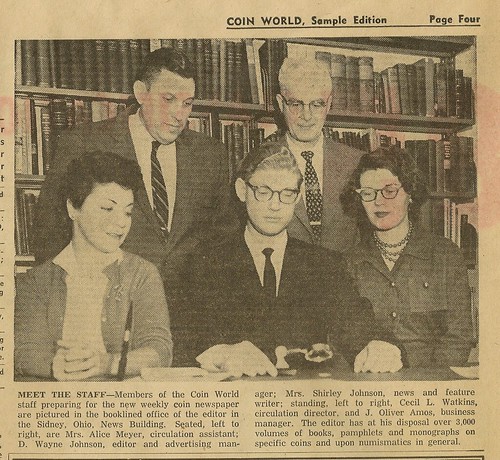
As COIN World approaches its 50-year anniversary, I wonder if a celebration or special issue is in the works.
MORE ON PROCESSING LAS VEGAS CASINO CHIPS
Phil Iversen writes:
Regarding the article Dick Johnson on the casino tokens donated at church services in Las Vegas he failed to mention that before the chips are turned in by the monks that they all have lunch made by the fish friar!
To read the earlier E-Sylum article, see: HOW DONATED LAS VEGAS CASINO CHIPS ARE PROCESSED (www.coinbooks.org/esylum_v13n01a17.html)
FEATURED WEB PAGE: MARYLAND COLONIAL CURRENCY 1744-1780
This week's Featured Web page is Scott Barman's presentation on Maryland Colonial Currency 1744-1780, given to the Montgomery County (Maryland) Coin Club on June 9, 2009. It was added recently to the MCCC web site.
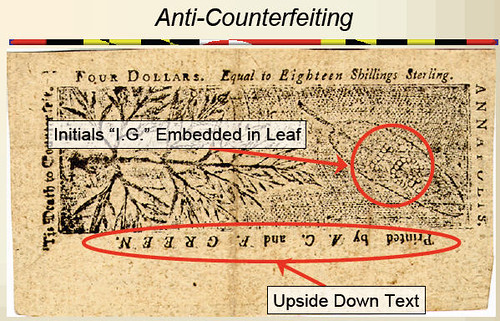
www.montgomerycoinclub.org/library/presentations
/MdColonialCurrency.pdf

